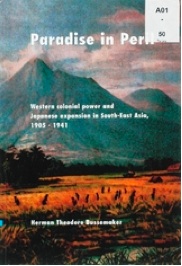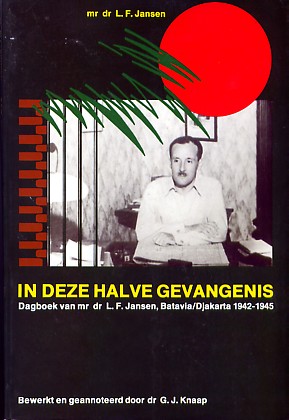On the History of the Pacific War
A Brief Note on the History of the Pacific War
by Boudewyn van Oort
This surely must be one of the most bizarre wars in recent history. Although its official commencement is given as Dec 7 1941, Japanese soldiers had by then already imposed Japanese imperial authority on Korea, Manchuria, French Indo China and a large part of China where a bloody conflict, punctuated by unspeakable brutality, was dragging on with no end in sight.
 All that happened was that on that fateful December Sunday Japan set its sights on the resource rich Netherlands East Indies, a colony whose Imperial master had recently fallen under the heel of the Third Reich. All that stood in the way of Japan’s lunge to the south was 2000 miles of Ocean and the questionable willingness of America and, let’s be generous, the ability of Britain to intervene in such a venture. The diplomatic manoeuvring preceding the conflict has been described in great detail by Dr Herman Bussemaker in his PhD dissertation for the University of Amsterdam (1).
All that happened was that on that fateful December Sunday Japan set its sights on the resource rich Netherlands East Indies, a colony whose Imperial master had recently fallen under the heel of the Third Reich. All that stood in the way of Japan’s lunge to the south was 2000 miles of Ocean and the questionable willingness of America and, let’s be generous, the ability of Britain to intervene in such a venture. The diplomatic manoeuvring preceding the conflict has been described in great detail by Dr Herman Bussemaker in his PhD dissertation for the University of Amsterdam (1).
A pre-emptive strike against the only significant opposing military force in this area enjoying, on Sunday December 7, a well-earned day of rest, made a Japanese defeat inevitable, but Japan could at the end of the war claim that with respect to one of its professed strategic objectives: ridding Asia of European dominance, she was successful. The Netherlands East Indies ceased to exists on March 8 1942, and for practical purposes that situation did not change with the ending of the war on 15, August 1945.
Did the atomic bomb end the war with the destruction of Nagasaki and Hiroshima? No, those apocalyptic blasts did not cow the Japanese Government nor its people but precipitated a hurried offensive by the Soviet army to ensure control over the Pacific Shores of Asia and perhaps a Communist act of retribution for the humiliation of the Tsarist defeat in 1905. Japan feared a Russian invasion more than an American one (2).
 It is small wonder that the Dutch and other European prisoners languishing in internment camps throughout south east Asia were so flabbergasted by the turn of events after the so-called Allied (actually American) victory. Prisoners they were before August 15 and prisoners they remained afterwards, only finding ultimate relief by exchanging their prison garb for that of refugees. There is no question as to who lost that war.
It is small wonder that the Dutch and other European prisoners languishing in internment camps throughout south east Asia were so flabbergasted by the turn of events after the so-called Allied (actually American) victory. Prisoners they were before August 15 and prisoners they remained afterwards, only finding ultimate relief by exchanging their prison garb for that of refugees. There is no question as to who lost that war.
Dr L.F. Jansen, the one Dutch observer on Java could see the entire drama unfolding from his vantage point working under duress in the Japanese propaganda bureau in Jakarta. He made a desperate attempt to forestall, what he saw as impending postwar disaster. As part of his work he listened to Dutch language radio broadcasts from Brisbane, Australia which betrayed no understanding to what extent the Indonesian population had become determined to avoid at all costs post war status as Dutch colonial subjects. He lost his life in the attempt to secretly warn by radio those Dutch Colonial authorities of the hostile reception they could expect. He would have sunk into oblivion were it not for the fact that his fascinating, intelligently written, insightful diary “in Deze Halve Gevangenis” (In this Semi Prison), survived the war and spurred its postwar owner into a investigation lasting twenty-three years to unmask the identity of the mysterious, intelligent, polyglot author and the personae discussed in his daily observations while working for the Japanese Authorities until his final fatal move. (3)
(1) Bussemaker, Herman Th., “Paradise in Peril”, PhD Thesis, University of Amsterdam, Faculty of the Humanities, 2001.
(2) Hasegawa, Tsuyoshi, “The Atomic Bombs and the Soviet Invasion, which was more important in Japans’ decision to surrender?” Stanford University, 2007.
(3) Jansen, Dr. Leo F., “In Deze Halve Gevangenis”, van Wijnen, Franeker 1988.
Other Books of note:
Dr Lou De Jong, “het Koninkrijk der Nederlanden”, Vol 11 deals with the Netherlands East Indies (1939-1945).Staatsuitgeverij, S’Gravenhage, 1985.
Johan Fabricius: “Brandende Aarde” , s’Leopolds Uitgever Maatschappij, the Hague, 1949. (regarding the role of Petroleum resources in the conflict).
Willem Remmelink, editor and translator: The Invasion of the Dutch East Indies, compiled by the National Defense College of Japan , Leiden University Press (2015)
Memoirs
Ernest Hillen: “the Way of a Boy”, Penguin, 1993.
Mark Felton: “Children of the Camps”,Pen & Sword, 2011.
Web Articles
Elizabeth van Kampen (http://www.dutch-east-indies.com/story/index.htm) Her lengthy account includes a particularly gruesome description of the pig basket atrocity.
Leave a Reply